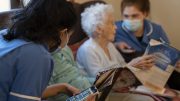In critical situations and the provision of first aid, time becomes a crucial factor, and staying abreast with the latest innovations can mean survival or death. This post delves into technological progressions that are transforming first aid. Ranging from intelligent devices offering immediate medical aid to state-of-the-art diagnostic instruments and life-preserving apparatus, these ground-breaking developments are poised to revolutionize our emergency response, guaranteeing swifter and more efficient care for those requiring assistance.
1. Computational Intelligence
In the present era, the advent of advanced computational intelligence (CI) has emerged as a transformative force in various sectors, including urgent care. Cutting-edge CI technologies possess the potential to completely reshape the way we address critical situations and offer immediate healthcare support. Equipped with state-of-the-art algorithms and data processing capabilities, CI can swiftly evaluate indications, deliver precise prognoses, and propose suitable measures, all within mere moments.
Envision a scenario where a CI-infused digital aide adeptly steers individuals through life-saving protocols, such as cardiopulmonary resuscitation (CPR) or applying pressure to halt bleeding, while the appropriate emergency services are en route.
2. Virtual Reality
Immersive digital technology, known as virtual reality (VR), has witnessed remarkable progress in recent times, unlocking unprecedented prospects in the domain of emergency response preparation. A notable application of VR in this context is the cutting-edge training for first aid. By utilizing a VR headset, learners can engage in lifelike situations and hone critical abilities within a secure and controlled virtual setting. From appraising the gravity of injuries to implementing life-preserving techniques, VR empowers individuals to acquire practical expertise and bolster self-assurance.
3. Remote First Aid Training
Traditional first aid courses often require participants to attend in-person sessions, limiting accessibility and convenience. However, institutions like Newcastle Training offer remote first aid training which harnesses the power of technology to overcome these barriers. Through online platforms, interactive video conferencing, and virtual classrooms, individuals can now receive comprehensive first aid instruction from certified trainers without leaving their homes. This innovative approach not only saves time and travel expenses but also opens up opportunities for individuals in remote areas or those with busy schedules to acquire vital knowledge and skills.
4. Telemedicine and Remote Assistance
Telemedical practices utilize advanced telecommunications technology to facilitate remote medical consultations, diagnostic procedures, and treatment recommendations. By means of video calls and secure messaging platforms, individuals can seamlessly connect with healthcare experts in real-time, receiving invaluable guidance and assistance, particularly in situations where physical access to healthcare facilities is restricted. This becomes especially pivotal in urgent circumstances where prompt decision-making and interventions are of utmost importance.
Remote assistance assumes a critical role in the realm of initial aid by enabling medical professionals to remotely mentor individuals in executing vital procedures. Leveraging live video streaming and enhanced reality tools, experts can evaluate injuries, direct onlookers through life-saving techniques, and in certain instances, even control medical apparatus from a distance. These innovative technologies empower individuals with the knowledge and proficiency of healthcare specialists, effectively bridging the gap until emergency responders are on-site.
In recent times, remarkable progress in technology has introduced an unprecedented phase in the field of initial assistance, fundamentally transforming our approach to emergency situations and expediting prompt medical support. By embracing these cutting-edge advancements, we can empower individuals to assume the role of proficient initial responders, thereby ensuring seamless accessibility to immediate healthcare, irrespective of geographical constraints. As we progress, let us wholeheartedly embrace and harness the potential of technology to forge a world that is both secure and resilient.





